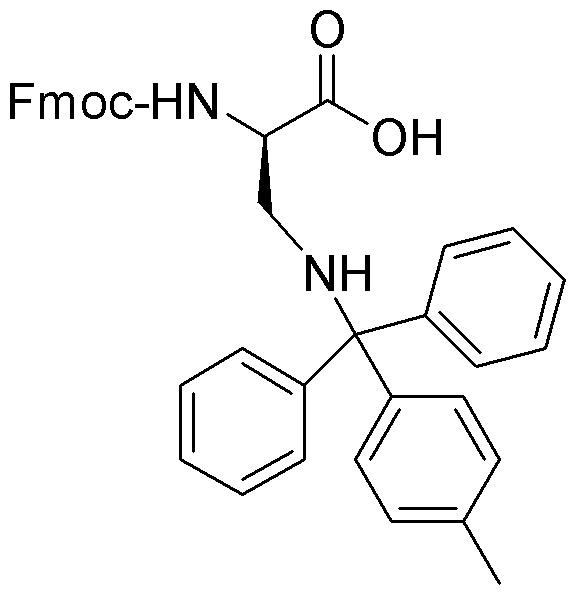Na-Fmoc-Nb-4-methyltrityl-D-2,3-diaminopropionic acid is widely utilized in research focused on:
- Peptide Synthesis: This compound serves as a key building block in the synthesis of peptides, allowing for the introduction of specific amino acid sequences in drug development.
- Drug Discovery: Its unique structure aids researchers in developing novel therapeutic agents, particularly in the fields of oncology and neurology, where targeted therapies are crucial.
- Bioconjugation: The compound can be used to create bioconjugates, which are essential for developing targeted delivery systems in pharmaceuticals, enhancing the efficacy of treatments.
- Research in Protein Engineering: It plays a role in modifying proteins to study their functions and interactions, which is vital for understanding disease mechanisms and developing new treatments.
- Advanced Material Science: The chemical’s properties make it suitable for creating smart materials that respond to environmental changes, useful in sensors and drug delivery systems.
General Information
Properties
Safety and Regulations
Applications
Na-Fmoc-Nb-4-methyltrityl-D-2,3-diaminopropionic acid is widely utilized in research focused on:
- Peptide Synthesis: This compound serves as a key building block in the synthesis of peptides, allowing for the introduction of specific amino acid sequences in drug development.
- Drug Discovery: Its unique structure aids researchers in developing novel therapeutic agents, particularly in the fields of oncology and neurology, where targeted therapies are crucial.
- Bioconjugation: The compound can be used to create bioconjugates, which are essential for developing targeted delivery systems in pharmaceuticals, enhancing the efficacy of treatments.
- Research in Protein Engineering: It plays a role in modifying proteins to study their functions and interactions, which is vital for understanding disease mechanisms and developing new treatments.
- Advanced Material Science: The chemical’s properties make it suitable for creating smart materials that respond to environmental changes, useful in sensors and drug delivery systems.
Documents
Safety Data Sheets (SDS)
The SDS provides comprehensive safety information on handling, storage, and disposal of the product.
Product Specification (PS)
The PS provides a comprehensive breakdown of the product’s properties, including chemical composition, physical state, purity, and storage requirements. It also details acceptable quality ranges and the product's intended applications.
Certificates of Analysis (COA)
Search for Certificates of Analysis (COA) by entering the products Lot Number. Lot and Batch Numbers can be found on a product’s label following the words ‘Lot’ or ‘Batch’.
*Catalog Number
*Lot Number
Certificates Of Origin (COO)
This COO confirms the country where the product was manufactured, and also details the materials and components used in it and whether it is derived from natural, synthetic, or other specific sources. This certificate may be required for customs, trade, and regulatory compliance.
*Catalog Number
*Lot Number
Safety Data Sheets (SDS)
The SDS provides comprehensive safety information on handling, storage, and disposal of the product.
DownloadProduct Specification (PS)
The PS provides a comprehensive breakdown of the product’s properties, including chemical composition, physical state, purity, and storage requirements. It also details acceptable quality ranges and the product's intended applications.
DownloadCertificates of Analysis (COA)
Search for Certificates of Analysis (COA) by entering the products Lot Number. Lot and Batch Numbers can be found on a product’s label following the words ‘Lot’ or ‘Batch’.
*Catalog Number
*Lot Number
Certificates Of Origin (COO)
This COO confirms the country where the product was manufactured, and also details the materials and components used in it and whether it is derived from natural, synthetic, or other specific sources. This certificate may be required for customs, trade, and regulatory compliance.


